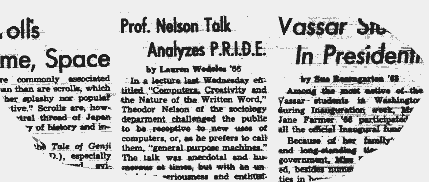|
ACM incorporates a principle similar to one named “transcopyright” by Ted Nelson. ACM will hold its copyrighted works on its servers and will give free and unlimited permission to create and copy links to those works or their components. So that readers can locate the context from which an excerpt was drawn, ACM will provide a way of linking a component to its parent work. Readers following links will gain access upon payment of a fee or presentation of a valid authorization certificate to ACM or ACM’s agent; ACM or its agent will issue a personalized certificate of ownership to that reader. – Association of Computing Machinery; ACM Interim Copyright Policy; Version 2; 1995-11-15. |
Ted Nelson invented hypertext, the concept behind links on the web, influencing several developers of the Internet, most notably Tim Berners-Lee.
Ted Nelson’s mother was an actress, and his father was a director. He went to Swarthmore College in the late 1950’s, where he became a film maker. He then went to graduate school at the University of Chicago in 1959, followed by Harvard University in 1960, where he took a course in computer programming using an IBM 7090 computer and began to think about writing a document management system to index and organize his collection of notes.
As he considered the design of this system, Nelson applied his experience as a filmmaker with the conception of complex motion picture effects, moving from one shot to another, and conceived of the idea of hypertext. He became profoundly convinced of the enormous value of such a system, and has been thinking and talking about it ever since (page once at http://web.archive.org/web/20001202050700/www.sensemedia.net/993).
Nelson’s first job was as a photographer and film editor at a Miami laboratory where John Lilly was carrying out research on the intelligence of dolphins, using LINC microcomputers to analyze their talking, as fascinated by acoustics as J.C.R. Licklider. Nelson then moved to a job teaching sociology at Vassar College.
The word “hypertext” was first coined by Nelson in 1963, and is first found in print in a college newspaper article about a lecture he gave called “Computers, Creativity, and the Nature of the Written Word” in January, 1965:
Nelson later popularized the hypertext concept in his book Literary Machines. His vision involved implementation of a “docuverse”, where all data was stored once, there were no deletions, and all information was accessible by a link from anywhere else. Navigation through the information would be non-linear, depending on each individual’s choice of links. This was more than text — it was hypertext. The web realizes part of this vision, except that there are deletions, and some information is stored in more than one place.
Nelson has continued to develop his theory, and instantiates it with Project Xanadu, a high-performance hypertext system that assures the identity of references to objects, and solves the problems of configuration management and copyright control. Anyone is allowed to reference anything, provided that references are delivered from the original, and possibly involving micro payments to the copyright holders.
For example, the Xanadu system would enable an artist to post their work in electronic form and let it be accessed any number of times, without having to worry about suddenly receiving an insupportable bill for network bandwidth costs. By adding useful structure, the system frees up the information and makes it available to everyone.
Nelson has also worked on the following systems:
- INLUV — Interactive Non-Linear Undo and Versioning — A rich compatibility standard for interconnection between different types of software.
- Transpublishing — A web enabled copyright and delivery method allowing people to republish other’s work freely. Nelson’s picture at the top of this page is transpublished.
- Zigzag — A multi-dimensional system of interconnections between all sorts of objects, processes, and documents, with a shareware version for Linux.
Some of the organizations Nelson has worked with are listed below:
- The Xanadu Group. Nelson first used the term “Xanadu” to refer to his hypertext vision in 1967. In 1979 Nelson convened The Xanadu Group, including Stuart Greene, Roger Gregory, Roland King, Eric Hill, Mark Miller, and K. Eric Drexler, to work on the design for a database and file system to implement a hypertext system.
- Xanadu Operating Company. Nelson created the Xanadu Operating Company, Inc. (XOC) in 1983.
- Hypertext Conference. The first hypertext conference was held in 1987, supported by 23 companies, including Apple Computer, Bell Communications Research, Harvard University, and Xerox PARC, and published 29 research papers.
- Autodesk. In February, 1988, the company Autodesk bought the Xanadu project and the Xanadu trademark. In August, 1992, they licensed the rights to the XOC software to Memex, Inc (later “Filoli”), named after Vannevar Bush’s system, and the “Xanadu” trademark was given back to Nelson.
- Serious Cybernetics. In 1993, Nelson reformulated his ideas as a system of business publishing relationships, and licensed the specification to Serious Cybernetics in Australia as Xanadu Australia.
- Sapporo HyperLab. In 1994, Nelson moved to Japan and founded the Sapporo HyperLab. The latest specification was licensed to what was then SenseMedia as Xanadu America. One of the last pages is here.
- Keio University. In 1996, Nelson became a Professor of Environmental Information at Keio University at Shonan Fujisawa, Japan.
- Oxford Internet Institute. In 2004, Nelson was the first recipient of a new Visiting Fellowship at Wadham College linked to the Oxford Internet Institute (OII).
Nelson also maintains a home page on hyperland.com.
Resources. Nelson’s hypertext ideas influenced the Hyper-G and Microcosm projects, Apple HyperCard — the first commercial hypertext system developed by Bill Atkinson, and the Lotus Notes workgroup software.

